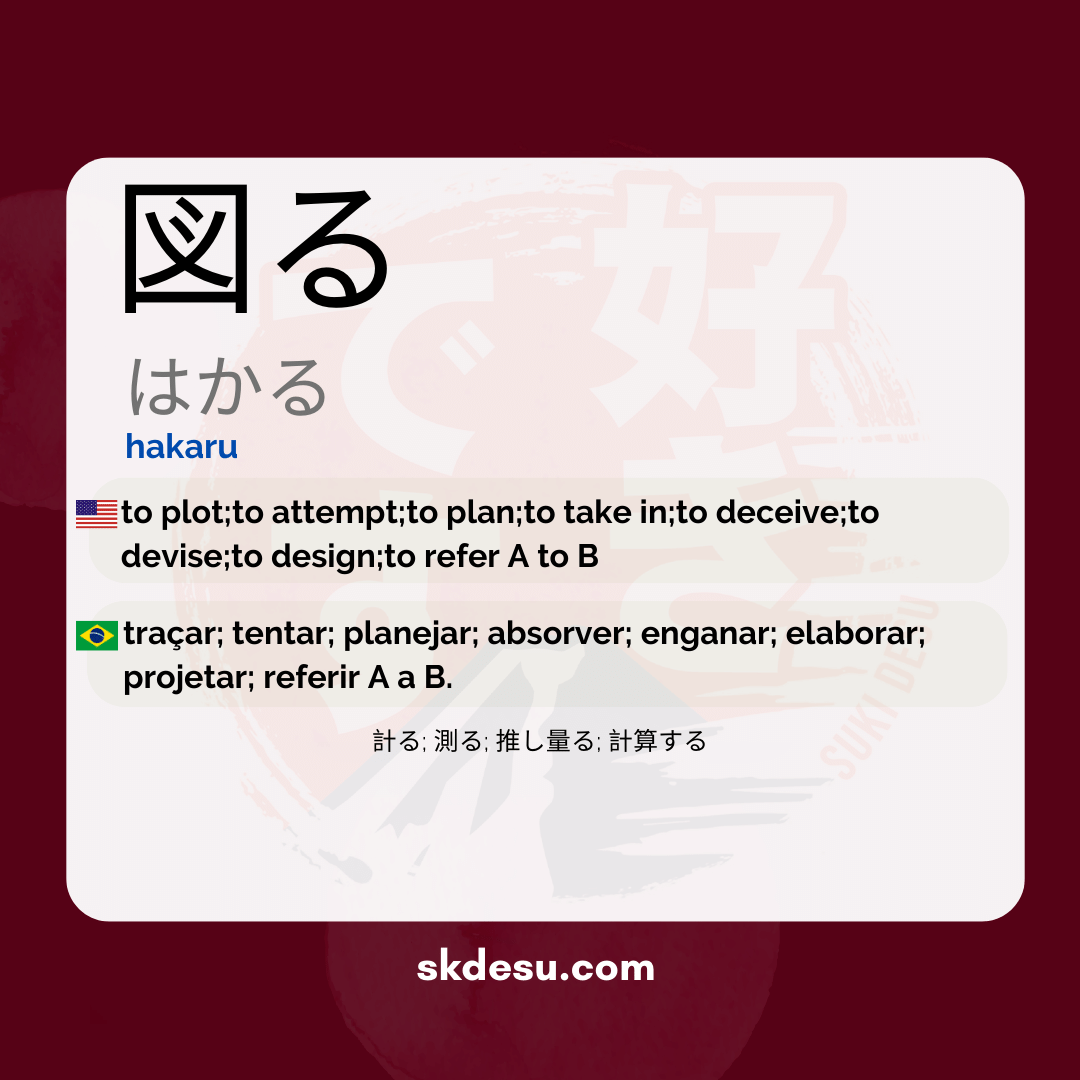Translation and Meaning of: 図る - hakaru
The Japanese word 図る [はかる] is a verb that carries interesting meanings and varied applications in everyday Japan. If you are studying Japanese or simply curious about the language, understanding how this word works can enrich your vocabulary and cultural understanding. In this article, we will explore the meaning, practical uses, and some peculiarities of 図る, from its writing to examples of how it appears in real contexts. Suki Nihongo, the best online Japanese dictionary, provides valuable details for those who want to master this expression.
Meaning and uses of 図る
The verb 図る [はかる] can be translated as "to plan," "to aim," or "to conspire," depending on the context in which it is used. It is often used to convey the idea of outlining a plan or pursuing a specific goal. For example, in professional situations, it may indicate the formulation of a strategy, while in more informal contexts, it may suggest a hidden intention.
A striking feature of 図る is its versatility. Unlike more restricted words, it adapts to various scenarios, from everyday conversations to formal texts. This makes it especially useful for those who want to communicate accurately in Japanese, whether in writing or speaking.
Origin and writing of kanji
The kanji 図 (which can also be read as "zu") has Chinese origins and carries the meaning of "map" or "diagram". This ideogram is composed of the radical 囗 (which represents a boundary or outline) and the component 啚 (which suggests the idea of planning). Together, they reinforce the notion of outlining something, whether it be a project or an intention.
It is worth noting that 図る is not an extremely common verb in everyday life, but it appears fairly frequently in written texts, such as articles, documents, and even in more elaborate dialogues. Its usage requires attention to context, as slight variations can completely alter the meaning of the sentence.
Tips for memorizing and using correctly
An effective way to solidify the meaning of 図る is to associate it with situations that involve planning or strategy. Think of scenarios like organizing an event, developing a project at work, or even planning a trip. These connections help internalize the verb naturally.
Another useful tip is to practice with short and simple sentences. For example: "新しいビジネスを図る" (to plan a new business) or "時間を図って行動する" (to act calculating the time). Repeating these examples aloud or writing them down on flashcards can speed up the learning process.
Vocabulary
Expand your vocabulary with related words:
Verb conjugation of 図る
- 図る - Gift Form: 図る
- 図る - Past form: 図った
- 図る - Imperative Form: 図れ
Synonyms and similar words
- 計る (hakaru) - Measure, calculate (usually used in contexts of time and quantity)
- 測る (hakaru) - Measure (usually used for physical measurements, such as length or temperature)
- 推し量る (oshihakaru) - Estimate, deduce (related to judging or inferring information)
- 計算する (keisan suru) - Calculate (referring to mathematical operations)
Romaji: hakaru
Kana: はかる
Type: verb
L: jlpt-n1
Translation / Meaning: draw; to try; to plan; absorb; to deceive; elaborate; design; refer A to B.
Meaning in English: to plot;to attempt;to plan;to take in;to deceive;to devise;to design;to refer A to B
Definition: To achieve a goal or desired state by making a plan or method.
Quick Access
- Vocabulary
- Writing
- Sentences
How to Write in Japanese - (図る) hakaru
See below a step-by-step guide on how to write the word by hand in Japanese. (図る) hakaru:
Example Sentences - (図る) hakaru
See below some example sentences:
Karera wa shinjuu o hakatta
They attempted a double suicide.
They tried in the heart.
- 彼ら - pronoun that means "they"
- は - Particle indicating the topic of the sentence
- 心中 - noun meaning "double suicide"
- を - Particle indicating the direct object of the sentence
- 図った - verb in the past that means "tried"
Other Words of this Type: verb
See other words from our dictionary that are also: verb

